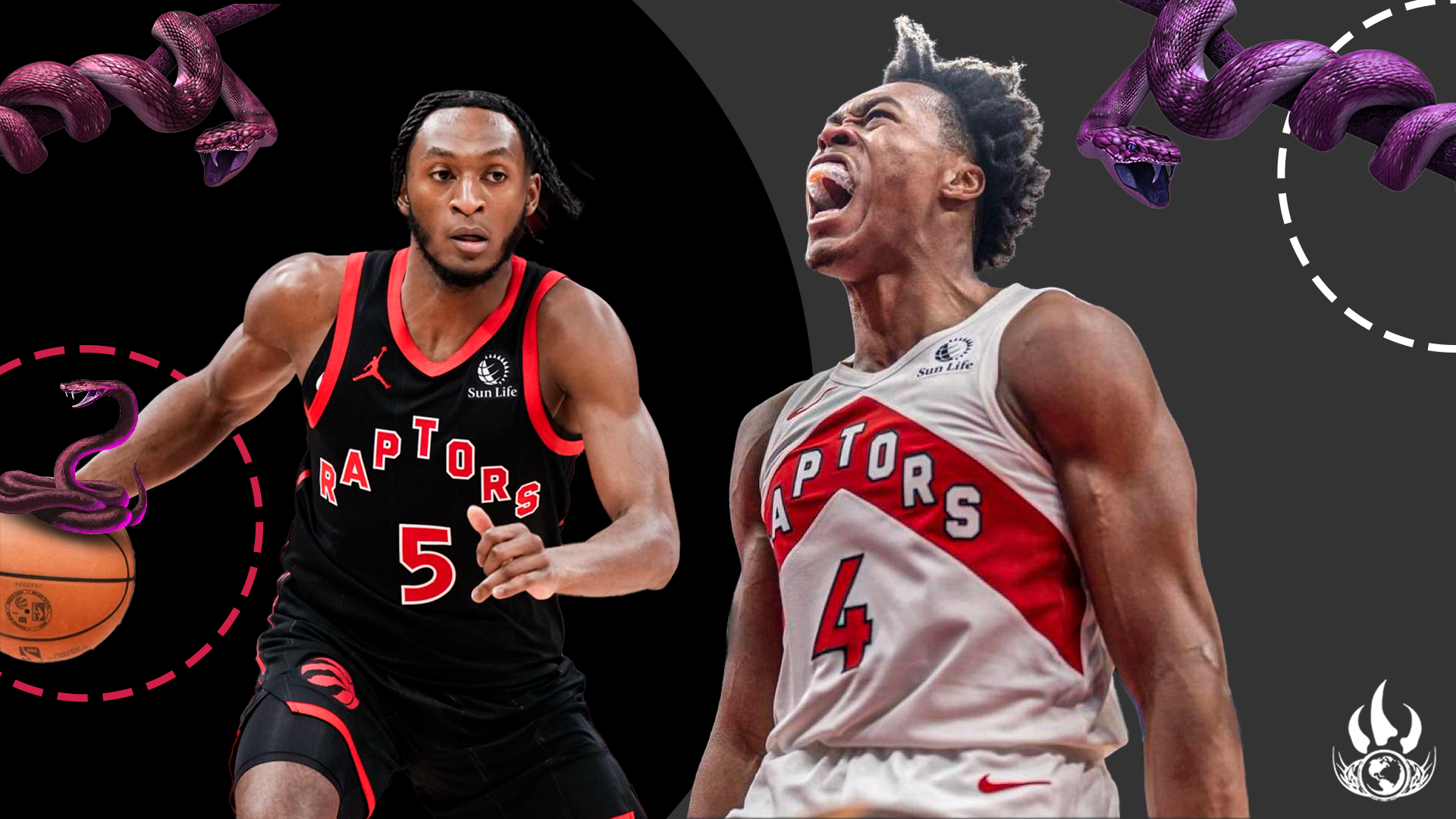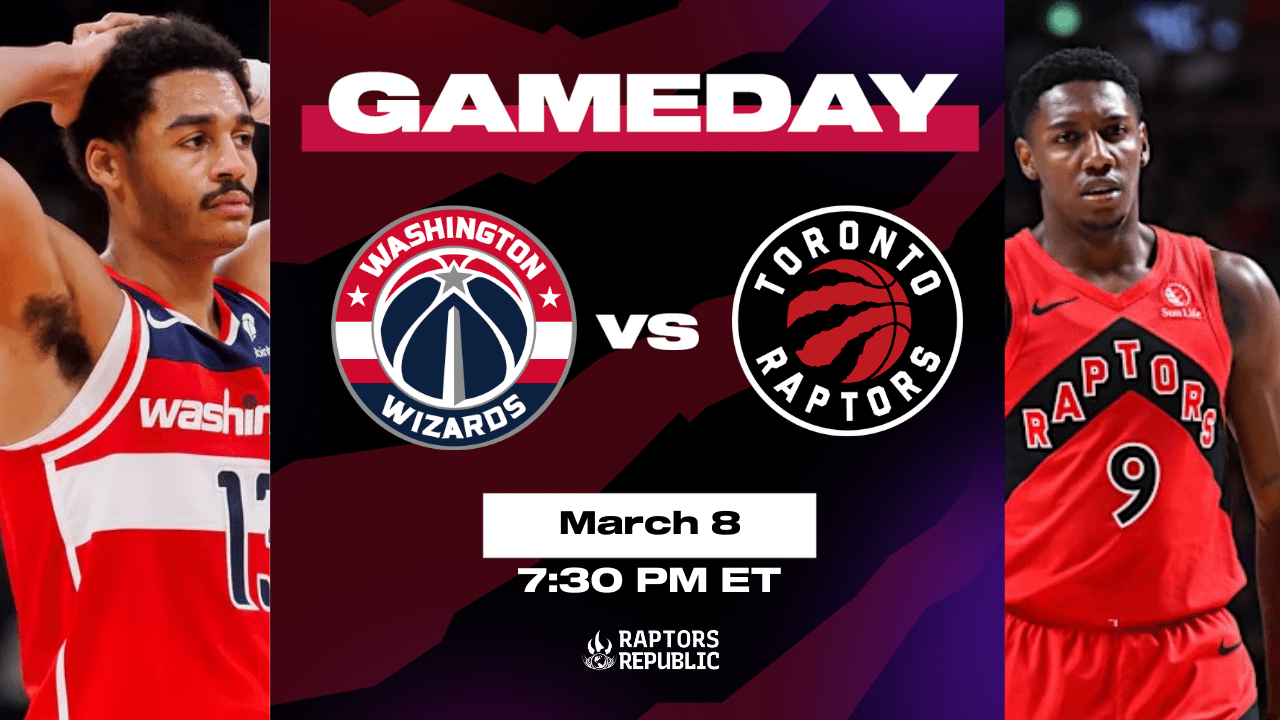Most passes that Scottie Barnes threw against the Utah Jazz flew to Immanuel Quickley. Most screens he set were to smash the Jazz defender guarding the speedster guard. It wasn’t a one-sided relationship. Quickley, too, constantly found Barnes with the ball and his screens. They were tied at the hip. When the Raptors called their first timeout, up 15-6 only five minutes into the game, both Barnes and Quickley sat on the bench together.
At one point early in the second quarter, Quickley outlet-ed the ball to Barnes, who pushed in transition. He didn’t find an opening, so he passed it back to Quickley in the half-court. Quickley drove and penetrated, as Barnes formed up behind him. Quick passed back to Barnes. Barnes shot (and missed). This was not a particularly unique possession. There was a lot of the two looking for one another. (Nor was the missed shot unique, either, but more on that in a moment.)
“They’re spending a lot of time together. After practices, they’re playing a lot of one-on-one. They’re talking about stuff on the court,” said Darko Rajakovic before the game. (He wouldn’t tell me who wins the one-on-one contests.)
“I’m really encouraging them to talk to each other, what they’re seeing, how they can help each other. So that’s an ongoing process that’s going to go into the summer, and it needs to become elite.”
If there’s anything the Raptors need to figure out this season, outside of acquiring a high draft pick, it’s the chemistry between Barnes and Quickley. It, like Quickley himself, has been slowly — slowly — improving. Darko Rajakovic told me midway through February that he is force-feeding Barnes and Quickley actions and minutes together. I wrote this then:
Rajakovic is very intentional about getting the duo on the same page. For the past three games, they have had virtually identical substitution patterns, spending 30 minutes together per game of Quickley’s 31 total. They averaged 24 minutes per game together prior to Feb. 9 (in games in which they were both healthy and playing). Getting the two on the court together, together, has been a real target.
It’s been more of the same since then, too. And as the Raptors are slowly shifting from development to arrested development, it’s clear that Toronto is still prioritizing getting Barnes and Quickley on the same page. Against the tanktastic Jazz, Toronto rested Jakob Poeltl and RJ Barrett. It’s clear what direction this team is going. But Barnes and Quickley remained in the game, playing almost exclusively their minutes in unison rather than Rajakovic opting to stagger their time on the court. Their development, individually and as a unit, is far more important to Toronto than the growth of the youngsters. Even if it comes in late-season, tankathon games that usually feature non-stars.
The upswing has started to show in the numbers. In terms of net rating, the Raptors have been better with Quickley and Barnes together than with either of them alone, or with neither on the court. It’s nothing special, with Toronto still losing those minutes with them on the floor. But it’s a step in the right direction.
“I think it’s a process,” said Rajakovic. “I think they’re doing some really good stuff. They’re finding each other. They’re developing a little bit more chemistry, pick and rolls with Scottie setting screens, and now he’s going for some lobs.
“I think IQ is getting more aware of situations when he can reject some of those pick and rolls to create his own shots. And now as they’re developing their own chemistry, it’s very important how they’re going to put that in the service of the team. When defense is rotating with the third guy, how we can find a pocket pass and playmake from there.”
It is, to be clear, very much a work in progress. The points per chance for both pick-and-roll combinations, with Barnes screening for Quickley and Quickley screening for Barnes, is below 0.9. That’s extremely bad. But the frequency is up. And if it was working perfectly, the Raptors wouldn’t need to be force-feeding actions to the duo. In fact, if it was working perfectly, Barnes and Quickley would probably have been resting against the Jazz, too, like Barrett and Poeltl.
(Although maybe not. Someone has to play. With Gradey Dick and Ochai Agbaji and Jonathan Mogbo out injured, the Raptors are running dangerously low on playable people. At multiple points against the Jazz, Toronto played full rotations of rookies and two-way players and 10-day players who have all appeared on the Raptors 905 together this season. It’s not like Utah was any better, with a huge portion of their rotation sitting, too.)
Barnes and Quickley checked out together early in the second quarter. They re-joined the game together again late in the quarter. Barnes missed a few jumpers, both coming off passes from Quickley. The duo were a combined 3-of-14 from the field at that point. Lots of passes from one to the other. Not a lot of actual scoring.
This is always a risk. That the two are out there just getting some run, rather than actually improving their games together. It’s hard to toe the line between development and, you know, intentionally losing basketball games. Toronto is trying to do both, at the very least. Unlike the Jazz. (Those Raptors rotations full of rookies and two-ways and 10-days? Yeah, they won their minutes, outside of a poor mid-fourth run.)
Walker Kessler gathered 18 first-half rebounds against the Raptors, physically unmanning Toronto’s overmatched center rotation of Orlando Robinson and Colin Castleton. Until late in the third quarter, Barnes mostly chilled out and took jumpers. And the Raptors led by 11 at half-time. It was unserious basketball all around.
Development is hard to come by in such situations. Losing season also happens to be take-what-you-can-get season.
The duo ran a pick and roll to start the third quarter. Quickley found Barnes on the short roll, and Barnes sprayed the ball to Ja’Kobe Walter in the corner. It was good process, but Walter missed the triple. Quickley caught fire thereafter, hitting a few triples as he jetted off handoffs and dashed away from the rim. Those were some of the only actions Quickley ran all night that didn’t involve Barnes. They rejoined the game together late in the third quarter and put on the jets as Barnes finally shifted from first to second gear and reached the rim for dunks and layups.
They played in the fourth, too. Every time I thought their night would be done, Rajakovic just kept keeping them on the floor. A Barnes handoff to Quickley in semi-transition turned into a pump-fake, a drive, a floater. The next possession saw Quickley receive another identical handoff from Barnes, and he created an open corner triple for teammate Jared Rhoden. They sat, finally, after that, each playing fewer than 30 minutes. But no! Then they returned with five minutes left to close out the game, unlike against Orlando in Toronto’s previous contest. They both hit the bench, again, together, with 94 seconds left. Again: development and a willingness to perhaps not play to the team’s full potential. Rajakovic is trying to balance both roads.
(When I asked Rajakovic after the game, he explained the different decision against Utah versus against Orlando simply because he is going to make those choices game-by game.)
Toronto won the game in a relative laugher, with their rookies and G-League call-ups better than Utah’s rookies and G-League call-ups. Quickley and Barnes had their moments, especially Quickley offensively — he hit a season-high 34 points as he got hot in the second half — and Barnes defensively, where he has become consistently a menace, a terror, a predator. But their ability to be more than the sum of their parts remains ethereal. There were points, especially in the fourth, where the vision lived. But as 2025 sinks deeper and deeper into wins-and-lessons season, the continual hunt for Barnes and Quickley together remains perhaps the most important on-court target for the Raptors.



